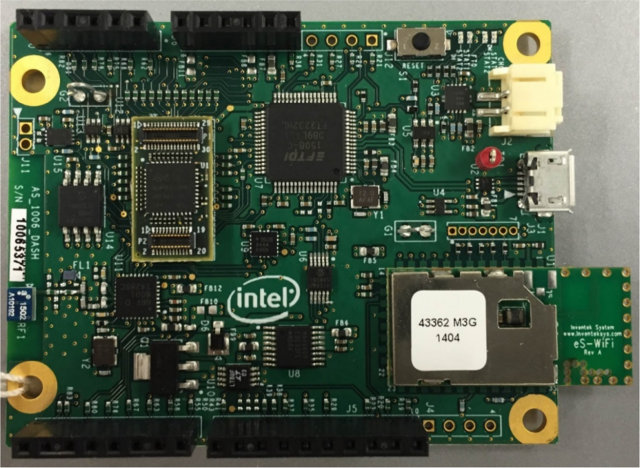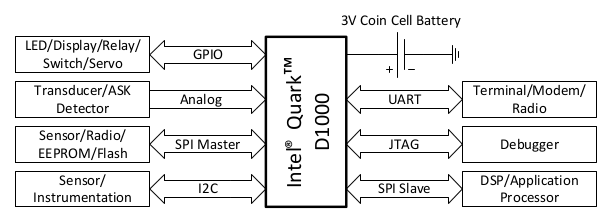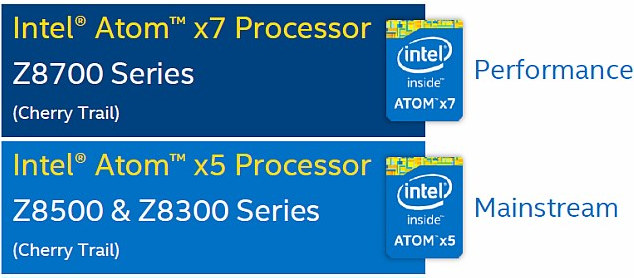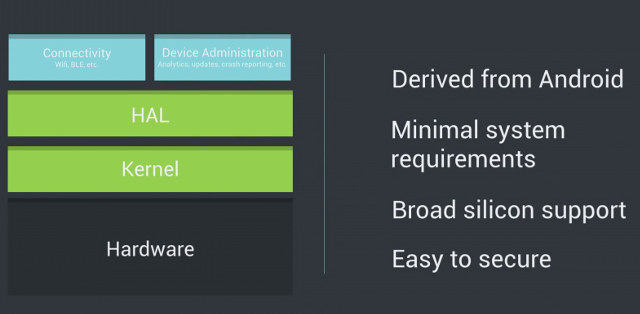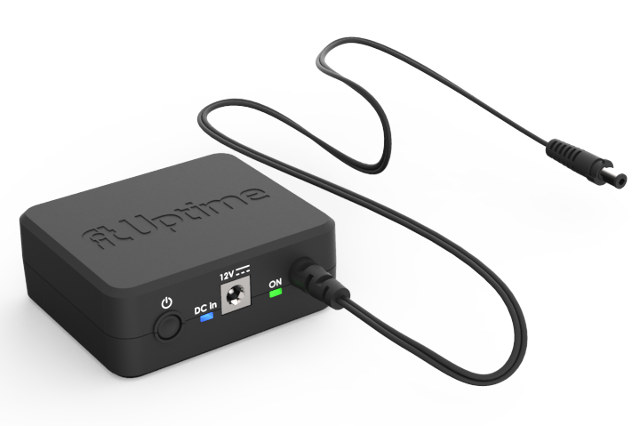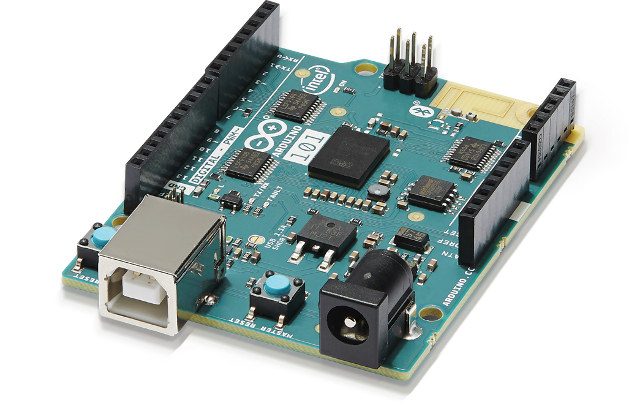We’ve previously seen there’s not that much difference in benchmarks between Intel Atom Z3735F and the newer Atom x5-Z8300 processor, except when it comes to 3D graphics performance where the latter can be up to twice as fast. The same benchmarks have been run in Windows 10 on an Atom x5-Z8500 based device, namely Kangaroo Mobile Desktop computer, and the difference seemed large enough that I decided to make a comparison against the Atom x5-Z8300 processor used in Tronsmart Ara X5. The three benchmarks – PCMark 8 (Accelerated 3.0), Passmark 8, and 3DMark – were run in Windows 10 64-bit Home in both devices. A Ratio greater than one indicates Kangaroo (x5-Z8500) is the faster device. Benchmark Tronsmart Ara X5 Intel Atom x5-Z8300 @ 1.44 GHz / 1.84 GHz (Turbo) Kangaroo Mobile Desktop Intel Atom x5-Z8500 @ 1.44 GHz / 2.24 GHz (Turbo) Ratio PCMark8 Overall Score 1,354 1,597 1.18 […]
Intel Quark D1000 Customer Reference Board and Intel System Studio for Microcontrollers
Intel unveiled Intel Quark D1000, D2000 and SE micro-controllers last week, with Intel Quark D1000 available now for $2.5 to $4 depending in quantities, and to my knowledge the first Intel MCU that can be considered ultra low power. I could not see a development board at the time, but Intel does have an Intel Quark D1000 Customer Reference Board with a familiar Arduino form factor. Intel Quark D1000 board specifications: MCU – Intel Quark D1000 32-bit CISC micro-controller @ 32 MHz Storage – 4MB SPI flash (Microchip ) Connectivity – Bluetooth LE radio, Wi-Fi (Inventek Systems Serial to Wifi module) Sensor – 3-axis accelerometer Expansion – Arduino compatible headers with GPIOs, I2C, SPI, UART, analog inputs, and 5V, 3.3V and GND. Debugging – mini USB port for programming and debugging; JTAG pins Power – 5V via mini USB port, or LiPo / Li-ion battery Dimensions – N/A Information about […]
Intel Unveils Three New Micro-controllers for IoT: Quark D1000, Quark D2000, and Quark SE
Intel’s subsidiary, Wind River, has recently announced two operating systems for the Internet of things with Rocket RTOS and Pulsar Linux supported respectively by Quark MCUs, and Intel Atom processors, as well as some ARM SoCs. But it’s not the only “IoT” announcement made by Intel in the last week, as I found out via EETimes that the company also unveiled three new Quark SoCs, namely Quark D1000, and Quark D2000, and Quark SE. Intel Quark D1000 Contrary to previous Quark processor and the upcoming D2000 and SE processors, D1000 is not compatible with x86 instructions set, and features the following: 32-bit Harvard CISC CPU @ 33 MHz with single cycle barrel shifter, two cycle multiplier, multi-cycle divider, integrated 32-bit timer, programmable interrupt controller, and JTAG debugger. 128-bit wide 32 kB code flash and 8 kB ROM 32-bit wide 8 kB SRAM and 4 kB data flash Osciallators 20-33 MHz […]
Intel Introduces 3 “New” Atom x5 and x7 Processors, a GPU Naming Scheme
Intel has a published a product change notification regarding an update to Intel Atom x7-Z8700, x5-Z8500, and x5-Z8300 processors with the new Intel Atom x7-Z8750, x5-8550, and x5-Z8350 processors with higher CPU burst frequencies, and some graphics fixes (Alpha Blending and ASTC issues). The company has also come up with a naming scheme for the Gen8 GPUs used in the processors with the 12EU (Execution Units) SKU being called HD Graphics 400, and the 16EU SKU called HD Graphics 405. That means there are now 6 Cherry Trail processors: Atom x5-Z8300 quad core processor @ 1.44 GHz with 1.84 GHz burst frequency and HD Graphics 400 Atom x5-Z8350 quad core processor @ 1.44 GHz with 1.92 GHz burst frequency and HD Graphics 400 Atom x5-Z8500 quad core processor @ 1.44 GHz with 2.24 GHz burst frequency and HD Graphics 400 Atom x5-Z8550 quad core processor @ 1.44 GHz with 2.4 […]
Wind River Introduces Free Cloud-based Operating Systems for IoT Applications
After Google Brillo operating system was officially launched last week, another company has announced free operating systems for IoT. What’s peculiar is that the company is Wind River a vendor of commercial operating systems whose typical business model is to sell licenses for their operating systems and fees for their development services. Nevertheless, the company has now introduced Wind River Rocket real-time operating system, and Wind River Pulsar Linux operating system. Both OSes will interface with the company’s Helix Cloud software-as-a-service (SaaS) products, which is probably how the company intends to monetize their work, on top of customization services. Wind River Helix App Cloud is currently made of three products: Helix App Cloud cloud-based development environment for building IoT applications Helix Lab Cloud cloud-based virtual hardware lab for simulating and testing IoT devices and complex systems. Helix Device Cloud cloud-based platform for managing deployed IoT devices and their data. Some […]
Brillo Android based OS for IoT Projects Supports ARM, Intel and MIPS Platforms
You’d think there are already enough lightweight operating systems that could provide a good enough platform for IoT and embedded projects, but Google decided to make their own Brillo operating system for IoT, based on Android, most probably to leverage the existing Android tools, and make it easier for app developers to move to the Internet of Things space. Brillo ‘s hardware requirements are pretty low as the operating system can run on devices with 32MB of RAM, and 128MB of storage. Google will provide a complete ecosystem with an embedded OS, core services, and a developer kit with tools to build, test, and debug. Just like in Android, three architectures will be be officially supports, starting with the following hardware platforms: ARM – TechNexion Pico-i.MX6UL system-on-module based on Freescale i.MX6 UltraLite and Broadcom BCM4339 802.11ac + Bluetooth 4.0 wireless module, combined with PICO-DWARF baseboard. MIPS – Upcoming MIPS Creator […]
Compulab fit-Uptime is a 12V mini UPS for Intel NUCs, fit-PCs, and More
Power failures can cause loss of data, or if you are unlucky even brick your devices, and for business users there may be a maintenance cost. UPS (Uninterruptible Power Supplies) prevent those issues by providing power when the mains fail, and while they are relatively inexpensive, they are quite bulky. That’s probably Compulab designed fit-Uptime a mini UPS taking 12 to 19V input and outputting 12V to keep mini PCs such as the company’s fit-PCs or Intel NUCs for a couple of hours. fit-Uptime specifications: Capacity – 18 watt hour Input: DC 12V to 19V Output on battery – DC 12V / 5A Output when powered – 12V to 19V (same as input) / 5A Battery – Lithium polymer built-in non-replaceable (good for up to three hours) Dimensions – 6.8 cm (l) x 8 cm (w) x 3.2 cm (h); Power jack: 5.5mm x 2.5mm barrel Weight – 240g The […]
Arduino 101 Board Features Intel Curie Module, Bluetooth LE, and Sensors
I’ve recently learned that the battle between the two Arduino teams, namely Arduino SRL (arduino.org) in Italy, and Arduino LLC (arduino.cc) in the US, had taken another turn with Arduino LLC now branding their boards as Arduino in the US, and Genuino in the rest of the world. This may certainly bring confusion to new comers, especially as they have to deal with different version of the Arduino IDE. With that backdrop, Arduino LLC has now introduced Arduino 101 (aka Genuino 101) board powered by Intel Curie module with Quark SE x86 SoC with Bluetooth LE and a 6-axis combo sensor. Arduino 101 specifications: SoC – Intel Curie compute module including an Intel Quark SE x86 32-bit microcontroller @ 32 MHz and an a DSP sensor hub @ 32Mhz with 384 KB flash, 80 KB SRAM (24KB available for sketches), , Bluetooth LE, and 6-axis combo sensor with accelerometer and […]



